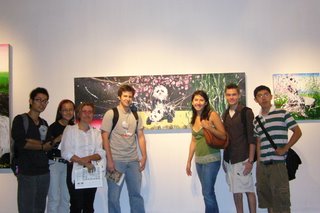Travel to Shanghai for its biennale, and you may find more shows than you had bargained for. As well as Hyper Design, the city's sixth biennale, housed in the Shanghai Art Museum, there are a host of other group exhibitions - some calling themselves "biennales" too - to investigate: Crossovers: Beyond Art and Design at the Contrasts Gallery; Entry Gate: Chinese Aesthetics of Heterogeneity at the Museum of Contemporary Art; the Second Shanghai Duolun Exhibition of Young Artists at the Duolon Museum of Modern Art; and another show organised by young artists that calls itself "the alternative biennale".
The number of satellite biennale platforms is as hard to ignore as the dearth of debate about their content. Instead of discussions about what these artists and curators have produced, many of the conversations taking place around these shows are focused on questions of monetary value.
ADVERTISEMENT
The market for Chinese art continues to soar. But commercial value alone is no proof of a work's intellectual worth; indeed, if its intellectual worth remains suspect, its long-term market value will be shaky. Remarkably, I have noticed only a few jabs at globalisation or consumer culture; there seems instead to be a wholly unironic celebration of capitalism's possibilities.
Another noticeable feature is the absence of politically charged art. Unlike the 1990s, there are few references to Mao Zedong or Tiananmen Square. What a New York Times article of March 2006 called "a quiet but forceful cultural revolution" now looks like an all-out rejection of any polical concerns among those exhibiting this season in Shanghai. For it is not merely, as the NYT noted, that "such artists operate without government interference." Rather, it is that - as the video artist Xu Zhen has put it - "now the Chinese government is more conceptual and forward-thinking than the artists".
Interestingly, some have returned to analyses of ancient Chinese traditions to make sense of new trends. For these observers, it is the history of centuries rather than of decades that provides an illustrative foil for these exhibitions. The catalogue essay for the Crossovers show by Li Xu, the former director of the Shanghai Museum, explains this comparative approach, and it is an explanation that applies equally well to MoCA's Entry Gate and to several of the works in Hyper Design. In earlier centuries, when referring to the concept of "art", the Chinese thought of ji shu, meaning craftsmanship, and xue shu, meaning knowledge. For items as diverse as teapots, gardens, calligraphy and poetry, there was no segregation of art and design. The wen ren or artist scholar was valuable because his creativity and skill implied spiritual and intellectual worth. Yet today a Chinese artist's social worth may too often be based on his market value.
Perhaps neither a lack of political content nor an emphasis on market value should be decisive factors in evaluating a contemporary art show's worth. But if Hyper Design is anything to go by, it is clear that the conceptual has been almost entirely taken over by the commercial in China.
But what of the exhibition's subtitle, The Practice of Everyday Life? Certainly, the Dutch artist and designer Atelier von Lieshout's free-standing desk/bed unit and the Chinese artist Liu Jianhua's "Dream Installation" - a shipping container overflowing with cheap plastic utensils - both involve considerations of work and the economy. So too does the impressive installation by Lee Kyung-Ho from South Korea, a landscape surrounded by video projections of more than 20 remote-control toy trucks at work in the space. These playtime work vehicles were imported to and sold on the street in Seoul, and, as'the artist explains, he "has brought them back home to work".
Another striking work-about-work is Zhou Wu's "Tribute to Handicrafts", an installation of white glazed ceramic tools that look like mummified antiques leaning against the wall. However, any implied concern with productivity is lessened by the juxtapositioning of Maurizio Mochetti's sleek hybrid model aircraft/human/penguin sculptures. The uncanny combinations in this Italian artist's squat, immobile gnomes are certainly preferable to another series of hybrid constructions by Daniel Lee, who uses Photoshop to combine human portraits with animal features, resulting in disturbing digital paintings. The most impressive digitised works based on photographs of people are by Julian Opie, who reduces the human figure to its most essential form and yet - despite the barest detail - renders the most dynamic movements. Opie's LED boxes are scattered throughout the exhibition.
Work by several artists such as Ceal Floyer, Kristian Ryokan and Nara Yashitomo are similarly dispersed. Floyer has two distinct wall works on different levels of the museum - one covering the wall's entire surface in diagonal strips of yellow and black adhesive tape, the other a discreet ready-made entitled "Spirit Level". Ryokan's flatly rendered oil paintings of everyday objects - a book spine, two-wheeled vehicles, modernist chairs - stylistically border on both photorealism and cartoonism. Often placed in rooms dominated by other artists, these pieces seems to question the supposedly therapeutic function of desire. They certainly challenge Yashitomo's doll-like children and animal made-for-museum-store products, pieces that nurture a compulsion to consume art objects not ideas.
Despite my attempts to consider these biennale exhibitions in terms of international contemporary art trends, the reality of sales almost always prevailed. Some of this is related to the spectacular performance of China's economy in recent years. As I was informed by a Hong Kong-born Stanford University MBA student, "a rise in the GDP of a specific culture does indeed mean an increase in the sale of that culture's art". While this assessment may become (or may already be) a reality for China and its art, my sense is that a culture of for-the-market art is not a good fit with art history's standards of measurement.
'Hyper Design' is at the Shanghai Art Museum until November 5. Tel +86 21 6327 2829

















